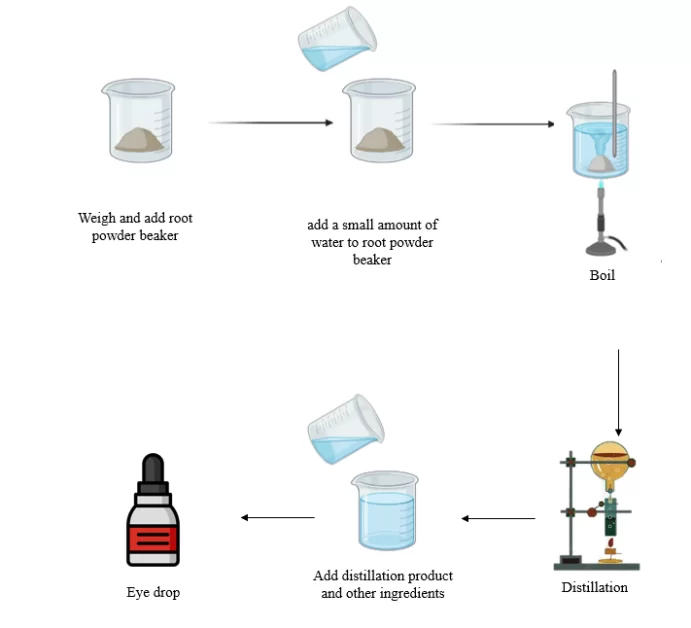BACKGROUND
Eye drop is sterile, primarily isotonic solutions with added lubricants or tears replacement agents. Due to its ease of development and production, this traditional dosage form for ocular administration accounts for 90% of the marketed formulations. Eye drops are liquid solutions that are placed directly on the surface of the eye.1
Aim- to prepare and submit the ear drop.
They are typically applied in small amounts, such as one or a few drops. Eyedrop instillation is still one of the less accurate but more widely used methods of topical drug delivery. For those who are older people, have poor vision and have trouble seeing without glasses, or have other physical limitations, the administration method is at best inconvenient. Surprisingly, the majority of patients master routine instillation quite easily.2
Environmental microbiological contamination with multidose packaging may result in a secondary eye infection. The ideal pH value is 7.4, which corresponds to the pH of tears and an osmolarity of 310 mOsm/kg. By prolonging eye drop residence time at the eye surface and increasing drug permeation through the cornea, ocular bioavailability can be enhanced.
In order to increase the efficacy of the formulations, excipients like permeation enhancers, cyclodextrins, and viscosity-increasing agents, are used. The corneal integrity is altered by a permeation enhancer, which also lowers barrier resistance. Polyoxyethylene glycol ester and ethylenediamine tetra-acetic acid sodium salt are two examples of permeation enhancers.
Due to its surfactant properties, benzalkonium chloride, which is frequently used as a preservative, can also serve as a penetration enhancer. Viscosity enhancers improve the drug’s local bioavailability and residence time on the eye by raising the viscosity of the solution.1
REQUIREMENTS
Apparatus: Beaker, Stirrer/glass rod, Measuring cylinder, spatula, balance, and storage bottle.
Chemicals: Punarnava root, Sodium Alginate, NaCl, Benzalkonium Chloride, and deionized water.
Formulation Table
| Sr.No | Ingredients | Quantity |
| 1 | Punarnava root | 6.23 gm |
| 2 | Sodium Alginate | 0.2 gm |
| 3 | NaCl | 0.09 gm |
| 4 | Benzalkonium Chloride | 0.01 % |
| 5 | Purified Water | 100 ml |
PROCEDURE OF EYE DROP
Preparation of Arka
Boerhaavia diffusa roots, which were powdered, were soaked in a small amount of water and left to soak overnight. As a result, the drug becomes pliable and when boiled, the volatile ingredients are easily released. The water was added and boiled the following morning after being poured into the distillation assembly (Akayantra).
A receiver was used to collect the vapor. The initial vapor may only contain steam and not have all of the necessary chemical components of the drugs, so it was discarded. The final serving was discarded and may not have contained any therapeutically important ingredients. The aliquots of the drug Punarnava (Boerhaavia diffusa) that are collected in between are known as Arka (aqueous distillate), and they contain the active ingredients.3
Preparation of eye drop
All ingredients were slowly mixed, and the aqueous distillate was added to make a volume of 10 ml. The mixture was then autoclaved, followed by U.V. radiation for 30 minutes, and stored in a 10 ml previously sterilized plastic screw-capped airtight container. Throughout the preparation, the phosphate buffer continuously kept pH at 7.2. 3
Use– inflammation, infection and other
Precaution– taken from2
- Always hold the dropper’s tip downward if it is separate.
- Avoid contacting any surface with the dropper.
- Do not rinse the dropper.
- When removing the cap, keep the dropper at the top of the bottle to prevent contamination.
- The same guidelines for preventing contamination apply when the dropper is a permanent fixture on the bottle (i.e., when it is given to the pharmacist by a pharmaceutical manufacturer)
- Never use eyedrops whose color has changed.
- If you are using multiple types of drops at once, wait a few minutes before using more drops.
- After applying drops, avoid tightly closing your eyes and attempting to blink less frequently than usual because doing so will wash the medication away from the area of your eye where it will be most effective.

CONCLUSION
Eye drop is prepared and submitted.
REFERENCES
- Dubald, M.; Bourgeois, S.; Andrieu, V.; Fessi, H. Ophthalmic Drug Delivery Systems for Antibiotherapy—A Review. Pharmaceutics 2018, 10, 10. https://doi.org/10.3390/pharmaceutics10010010
- Felton L, Remington: Essential of Pharmaceutics, am, J.Pharm.Educ. 2013
- Pooja, & Lal, V. & Verma, Anurag. (2016). Development and Evaluation of Ophthalmic Drop and in-situ Gel from Roots Of Boerhaavia Diffusa. British Journal of Pharmaceutical Research. 11. 10.9734/BJPR/2016/24395.
Also read:
- Preparation of after shave lotion
- Preparation of tooth paste
- Preparation of vanishing cream
- Preparation of Nasal drop
- Preparation of ear drop
- Determination of saponification value of the given oil/fat
- Determination of saponification value of fat (coconut oil)
🔴 Would you like to attempt Labmonk Daily quiz? Click here
🔵 Check out Jobs & Exam Notices. Labmonk Notice Board
🔴 Labmonk Scholarships. Click here
🔵 Labmonk Blog. Click here
🔴 Do you need notes? Click here
Watch Career related videos on Youtube: Watch now !!
FAQ
Pull the lower eyelid down slowly with one hand. To fill a dropper with liquid if the dropper is separate, squeeze the rubber bulb once while the dropper is inside the bottle. Drop the medication into the lower lid while looking up and holding the dropper above your eye; avoid touching your fingers or your eye. Lower the lid, and open it. Try not to blink for at least 30 seconds while keeping your eye open.
The ideal pH value is 7.4, which corresponds to the pH of tears and an osmolarity of 310 mOsm/kg.
No. OTC and prescription eyedrops are different, as OTC eye drops are general eyedrops but prescription eye drops required to be taken on doctors suggestion only.



